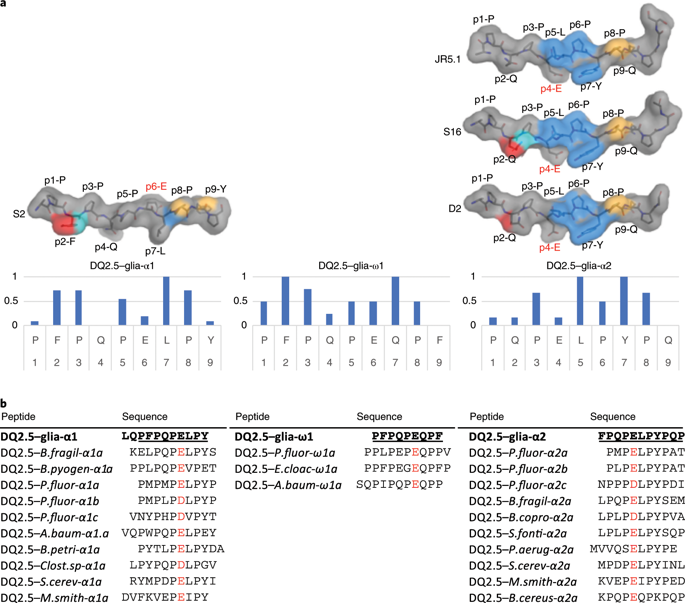当前位置:
X-MOL 学术
›
Nat. Struct. Mol. Biol.
›
论文详情
Our official English website, www.x-mol.net, welcomes your
feedback! (Note: you will need to create a separate account there.)
T cell receptor cross-reactivity between gliadin and bacterial peptides in celiac disease.
Nature Structural & Molecular Biology ( IF 12.5 ) Pub Date : 2019-12-23 , DOI: 10.1038/s41594-019-0353-4 Jan Petersen 1, 2 , Laura Ciacchi 1, 2 , Mai T Tran 1 , Khai Lee Loh 1 , Yvonne Kooy-Winkelaar 3 , Nathan P Croft 1 , Melinda Y Hardy 4, 5 , Zhenjun Chen 6 , James McCluskey 6 , Robert P Anderson 7 , Anthony W Purcell 1 , Jason A Tye-Din 4, 5, 8 , Frits Koning 3 , Hugh H Reid 1, 2 , Jamie Rossjohn 1, 2, 9
Nature Structural & Molecular Biology ( IF 12.5 ) Pub Date : 2019-12-23 , DOI: 10.1038/s41594-019-0353-4 Jan Petersen 1, 2 , Laura Ciacchi 1, 2 , Mai T Tran 1 , Khai Lee Loh 1 , Yvonne Kooy-Winkelaar 3 , Nathan P Croft 1 , Melinda Y Hardy 4, 5 , Zhenjun Chen 6 , James McCluskey 6 , Robert P Anderson 7 , Anthony W Purcell 1 , Jason A Tye-Din 4, 5, 8 , Frits Koning 3 , Hugh H Reid 1, 2 , Jamie Rossjohn 1, 2, 9
Affiliation

|
The human leukocyte antigen (HLA) locus is strongly associated with T cell-mediated autoimmune disorders. HLA-DQ2.5-mediated celiac disease (CeD) is triggered by the ingestion of gluten, although the relative roles of genetic and environmental risk factors in CeD is unclear. Here we identify microbially derived mimics of gliadin epitopes and a parental bacterial protein that is naturally processed by antigen-presenting cells and activated gliadin reactive HLA-DQ2.5-restricted T cells derived from CeD patients. Crystal structures of T cell receptors in complex with HLA-DQ2.5 bound to two distinct bacterial peptides demonstrate that molecular mimicry underpins cross-reactivity toward the gliadin epitopes. Accordingly, gliadin reactive T cells involved in CeD pathogenesis cross-react with ubiquitous bacterial peptides, thereby suggesting microbial exposure as a potential environmental factor in CeD.
中文翻译:

乳糜泻中麦醇溶蛋白和细菌肽之间的 T 细胞受体交叉反应性。
人类白细胞抗原 (HLA) 基因座与 T 细胞介导的自身免疫性疾病密切相关。HLA-DQ2.5 介导的乳糜泻 (CeD) 是由摄入麸质引发的,尽管遗传和环境风险因素在 CeD 中的相对作用尚不清楚。在这里,我们确定了微生物衍生的麦醇溶蛋白表位模拟物和亲本细菌蛋白,该蛋白由抗原呈递细胞和激活的麦醇溶蛋白反应性 HLA-DQ2.5 限制性 T 细胞从 CeD 患者中自然加工。与 HLA-DQ2.5 复合的 T 细胞受体的晶体结构与两种不同的细菌肽结合,表明分子模拟支持对麦醇溶蛋白表位的交叉反应。因此,参与 CeD 发病机制的麦醇溶蛋白反应性 T 细胞与普遍存在的细菌肽发生交叉反应,
更新日期:2019-12-23
中文翻译:

乳糜泻中麦醇溶蛋白和细菌肽之间的 T 细胞受体交叉反应性。
人类白细胞抗原 (HLA) 基因座与 T 细胞介导的自身免疫性疾病密切相关。HLA-DQ2.5 介导的乳糜泻 (CeD) 是由摄入麸质引发的,尽管遗传和环境风险因素在 CeD 中的相对作用尚不清楚。在这里,我们确定了微生物衍生的麦醇溶蛋白表位模拟物和亲本细菌蛋白,该蛋白由抗原呈递细胞和激活的麦醇溶蛋白反应性 HLA-DQ2.5 限制性 T 细胞从 CeD 患者中自然加工。与 HLA-DQ2.5 复合的 T 细胞受体的晶体结构与两种不同的细菌肽结合,表明分子模拟支持对麦醇溶蛋白表位的交叉反应。因此,参与 CeD 发病机制的麦醇溶蛋白反应性 T 细胞与普遍存在的细菌肽发生交叉反应,











































 京公网安备 11010802027423号
京公网安备 11010802027423号